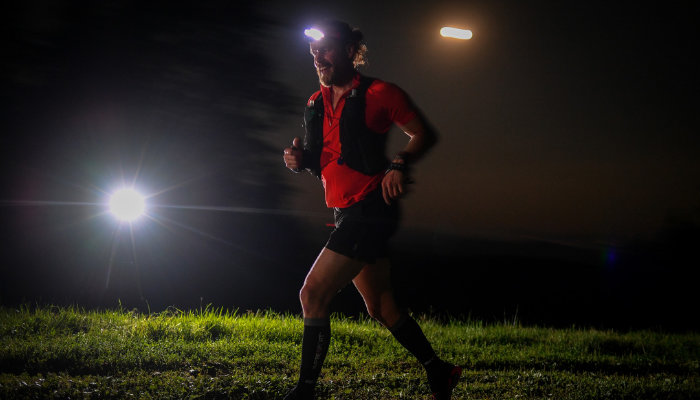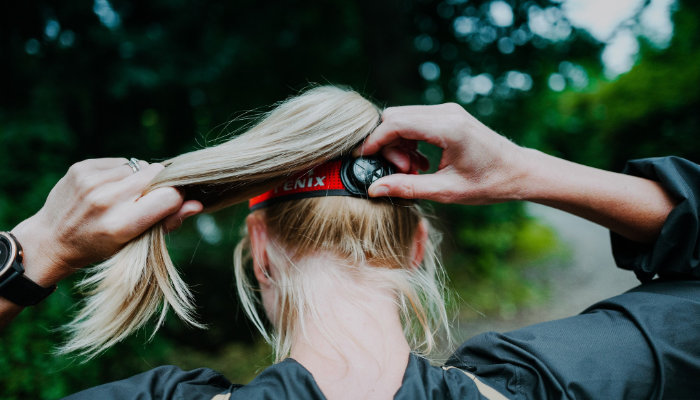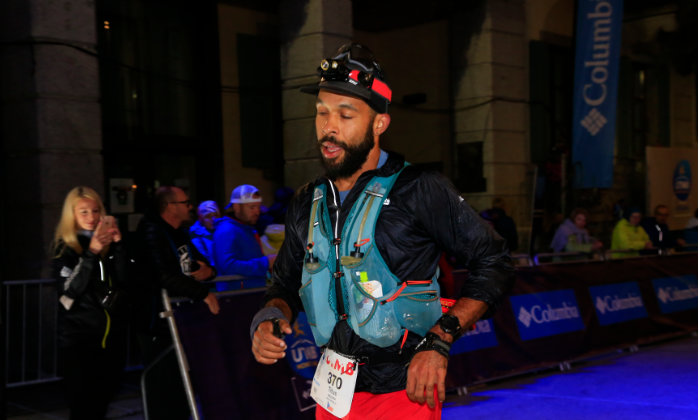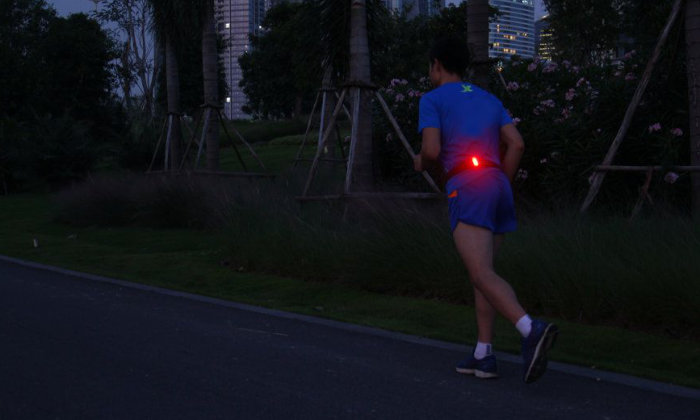Headlamps for running 2023-2024
12.10.2023
Is running your passion and do you run year round? Do you train in the evenings in dark and in poor visibility from autumn to spring? During ultra races, do you need a running headlamp that won't let you down? We'll help you tackle the darkness with a powerful headlamp, whatever your reasons and motivations for running in the dark. A great overview of Fenix headlamps suitable for running is here!

Ales Zavoral with the Fenix HM65R-T headlamp at the Týništské šlápoty
Recreational running
If you just want to stretch out your body tortured all day in an office chair and don't need a special track to do it, running in the dark doesn't have to be a big deal. Just head out around the town or to the park, and you'll most likely be accompanied by public lighting the whole time. A headlamp with basic specs or any compact handheld flashlight that you can hold in your hand for a few minutes will suffice as a personal light.
The Fenix HL range of headlamps is just right for the casual and occasional runner or beginner. The headlamps are resistant to heavy rain and are shockproof as well. Often the battery can be replaced with disposable batteries, or the headlamp is designed specifically to be powered by disposable batteries. Also the 36 mm wide strap is great, which sits beautifully on the head and, on higher models, can be tightened comfortably with one hand with the tightening wheel (SportFit system). Reflective elements increase passive safety when moving along the road.
The Fenix HL16 is worth mentioning from the lightweight running headlamps, it is powered by three AAA batteries. You can use disposable batteries or NiMH batteries. The power output up to 450 lumens is fully sufficient for city runs or shorter off-road runs. The weight is just under 100 grams and it is sold in several colour options, so there is something for everyone. Of course, the headlamp is also suitable for other activities and the red light can be an advantage. The HL16 is also suitable for children who will appreciate the bright colours of the headlamp.
The rechargeable Fenix HL18R-T, you'll appreciate its low weight of 91 grams in addition to its ample light output and runtime for recreational running. The advantage is the rechargeable battery, so there is no need to change batteries, but you can conveniently recharge the headlamp after your run for the next time. On the other hand, three AAA batteries can be used in the headlamp as an emergency option, or if you own NiMH batteries with charger you can youse those as well.

Fenix HL18R-T - the female runners will appreciate

Tightening wheel for adjusting strap length
Fenix HL32R-T comes in three beautiful color options. The body of the headlamp is made of magnesium alloy. It is the most powerful variant in the HL range and also has the highest capacity battery 1900 mAh. 800 lumens of the strongest power and high endurance suit even the most demanding runners and you can use it even during trail runs or night races. Again, three AAA batteries can be used in an emergency.
Want to enjoy the night trail
Decided to go all in on running, running several times a week and running off the paved trails? You'll still be interested in adequate light output, easy charging and of course weight (a parameter that women watch especially closely). But there are others: the shape of the light cone, weather resistance, or power method and power regulation. The latter two should not be neglected, as they determine whether you will find yourself in the dark in the middle of the woods with a dead battery.
It's probably hard to find a 100% ideal that suits absolutely everyone, yet the position of certain universals is fulfilled by the rechargeable headlamps Fenix HM50R V2.0 and Fenix HM51R Ruby V2.0. Both are lightweight with a durable duralumin body, which is housed in a hardened plastic holder using a metal clip that doesn't press on the forehead. The replaceable lithium-ion battery RCR123A is simply charged inside the headlamp via a modern USB-C connector. At maximum they reach a consistent output of 700 lumens. However, you will use this mode rather complementarily, e.g. when looking for a hiking marker while running in an unfamiliar environment. The most suitable medium mode for runners is 130 lumens for the HM50R V2.0 and 150 lumens for the HM51R V2.0. S With this light output, you can run safely on paved and natural trails.
What you'll probably consider most is how to regulate the power. The HM50R V2.0 uses electronics with a extended runtime function. The headlamp power is thus gradually reduced in , who regularly runs all night passages of his ultra-runs with this Fenix. It's not for nothing that it's been dubbed the the headband that runs the Spartathlon.

Radek Brunner with Fenix HM50R V2.0 headlamp in Spartathlon finish
His sister Fenix HM51R Ruby V2.0 features constant power control. Thus, the individual modes shine constant until the battery is tight and then automatically switch down a degree. For the running mode with 150 lumens, this means about 2.5 hours of the same light output which is enough for most of us to train. The exception is the highest mode, where the gradual reduction of power has the function of a fuse against overheating. The small and compact body of the headlamp cannot permanently cool the heat generated during the highest mode operation. Its light source is a Cree XP-G3 LED with warmer white light shade for better color and shape perception. This can be especially useful in more difficult terrain, where you won't be surprised by a steeper slope or a protruding branch.
The Fenix HM50R V2.0, on the other hand, is equipped with a diode with daylight tint, which is a bit cooler and gives the subjective feeling of more power, which is especially appreciated by runners on clear trails (roads and groomed trails). If you're interested in more differences between the two headlamps, check out our comparison article.
The well-known running promoters from Running2.cz have already tested the original version of the HM51R, which they liked especially for its durability, light weight or warmer shade of white light (neutral white). With the new generation, they especially appreciated the ability to easily remove the headlamp body from the head strap and use it, for example, when fog suddenly falls and needs to be illuminated. You can then either hold the headlamp directly in your hand or attach it to your clothing or backpack with the included metal clip. Read more in their review.

In the foreground Michal Hrabec from Running2.cz with headlamp Fenix HM51R Ruby V2.0
The aforementioned Fenix HL32R-T, which modes replicate these two universals from the
For long night runs and ultra races
If you're a fan of long running races, a good portion of which take place in the dark, you need to think about a light with enough power and, above all, endurance. Shining a headlamp on any smaller batteries than just a Li-ion 18650 or 21700 means preparing to either swap out spare batteries on the fly or pulling out a backup headlamp. More power may seem unnecessary, but especially if you're running in little-known or wild terrain, driving lights can come in handy here too for quick orientation.
Of course, a stronger battery also means more weight, so the basic question of choice will run on the endurance versus weight axis. Fenix tries to meet users as much as possible in this direction as well, and although it increases the power, it manages to reduce the weight of its ultra-powerful rechargeable headlamps. After all, it has gone from 167 grams / 950 lumens in the days of the Fenix HL60R to 157 grams / 1,600 lumens in the Fenix HM61R Amber V2.0 and, thanks to the use of magnesium alloy, up to 141 grams / 1,500 lumens in the Fenix HM65R-T. Some women might already be worried about this weight, but on the other hand, they would love to indulge in that kind of power and feel safe while running. From the experience of many users, if you adjust the headlamp straps well before running out, the weight is not a problem even for more fragile female runners.
The two-eyed Fenix Fenix HM65R-T offers a practical combination of a remote and a wide-spread reflector. The wide reflector with maximum 400 lumens can be used as more than comfortable lighting for most of a night run. The warmer shade of white light will again highlight the colours and shapes of the surrounding environment. Alternatively, you can help yourself with a remote reflector with a focused centre and a daylight white tint. As both reflectors can be switched on at the same time, you can also set the unique combination of wide and main beam to the right intensity for your needs. And since the -T in the designation means it is a running special, the HM65R-T is also fitted with a SportFit strap with tightening wheel. Our ambassador Titus Ablorh chose it for his participation in races such as the UTMB (Ultra Trail du Mont Blanc). It has served him well on the long challenging courses of these races, including the high elevation.

Titus Ablorh crosses the finish line at UTMB 2021 in a time of 30:09:51
The Fenix HM65R-DT is also designed in the same way, which unlike the HM65R-T is equipped with two main reflectors with different light temperatures ranging from 3000 K on the secondary reflector to 5500 K on the main more powerful reflector. It therefore does not illuminate the surroundings as much and is really suitable for fast terrain movement, in addition to running on runs or skialps or MTB.
Fenix HM61R Amber V2.0has a single reflector that can deliver up to 1600 lumens thanks to the advanced Luminus SST-40 diode. The range of light modes seems optimal for running: 5 lumens – indication lighting, I can see for cars, 50 lumens – clear terrain and paved roads, 150 lumens – regular night running on forest paths with 12 hours constant lifetime, 400 lumens – complex terrain and downhill runs, 1600 lumens – short-term orienteering or dangerous terrain, but if 2 hours of endurance is enough for you, you can also use it permanently and enjoy running like daytime : ) The headlamp features multifunctionality. One essential parameter for running is the ability to easily remove the headlamp body from the strap and use it as a handheld flashlight in fog or opaque terrain. It is great to use on the bike, cross-country skiing, ski-alpine and other sports as well as a working headlamp.
The Fenix HM61R Amber was quickly adopted by our ambassador Ales Zavoral, who is a shining example of how it can be used in other activities. In addition to the Prague Hundred, he also takes part in long-distance bike races without support. For example, Atlas Mountain Race - one of the hardest nonstop races of this type on the African continent. But it wasn't just this headlamp, check out its complete lighting equipment.

Ales Zavoral and Fenix HM61R Amber during Atlas Mountain Race 2020
Even better performance will be offered by Fenix headlamps powered by the larger 21700-type battery, which are the Fenix HM70R and HM71R. Again, the main advantage here is the long runtime for typical running modes (about 150-200 lumens) or the maximum output of 1600-2700 lumens, which already surpasses the output of car driving lights. This can be of use, especially if you use traffic while running, you will easily draw the attention of any road pirates. On the other hand, with a weight of just over 200 grams already, it may not really suit everyone.
Additional safety lighting
Even when running at night, the rule of thumb is that it is important not only to see, but more importantly to be seen. The Fenix BC05R V2.0 sports rechargeable flashlight can then become a practical accessory. Although originally designed primarily for cyclists, the package also includes a clip that can be used to attach the flashlight to the back of a headlamp strap or to other items of clothing or a backpack. For an overview of its capabilities, check out this test.

Fenix BC05R on a kidney belt as a practical back light for runners
Important parameters
Let's summarize once again all the parameters that matter.
- dimensions
- Lighter flashlights just need a strap around the head, heavier ones should also have a center strap across the top of the head or be equipped with a SportFit strap.
- The headlamp should sit with its center of gravity so that it does not slide on the forehead when bouncing while running.
- weight (the lower the better, obviously, but this is at the expense of endurance).
- light output
- you need 3-5 modes of light output, more when controlling it delays
- indicative (you can be seen while running and helps in dim or in clear terrain) 5-30 lumens.
- running on asphalt or a clear dirt road 30-150 lumens
- operating (for running in terrain, depending on cone width 100-300 lumens, can be divided into two modes)
- boost (distance view or threat blindness) 300 - 1600 lumens
- what you usually don't need: white flash or SOS signal
- what you may need: red position light, which is attached to the back or side of the flashlight, but can be purchased separately. Fenix also offers straps with reflective markings on most of its headlamps.
- you need 3-5 modes of light output, more when controlling it delays
- compactness
- The more miscellaneous components a flashlight has, the more likely something can go wrong. For this reason headlamps with separate batteries are not so useful when running, the cable is usually the weakest point of headlamps of all manufacturers.
- light cone width
- mid-width is preferred by the majority of runners. Fenix headlamps main narrow beam of light is directed forward and the wide halo of light illuminates the area just ahead of you, so you can see clearly where you are pedaling.
- Wider fits in dangerous and opaque terrain where your peripheral vision should be working too.
- Variable light cone width: an unnecessary feature that usually just makes the flashlight design thicker and shifts the center of gravity forward at a disadvantage. You won't change the cone width on the fly anyway, or you'll be distracted by changing it.
- Avoid headlamps with a very narrow point cone, they may have a long range, but it's good to see where you're stepping.
- torch control
- it should be as easy as possible to both turn off and on, and switch the light mode.
- it should be intuitive so you don't get confused and accidentally turn the flashlight off.
- On long runs, it is often necessary to be able to change the power supply blindly, i.e. to make it easy to open the battery block, remove it and insert a new one with solved reverse polarity protection. Practice this.
- don't forget to practice adjusting the straps on your flashlight and set them up correctly beforehand
- in any case, get familiar with the flashlight controls some other time than the start of the main race season :)
- durability
- Waterproofing is necessary for running virtually anytime. The flashlight must survive in a steamy pocket. If you are running in particularly inclement weather, waterproofing (i.e., resistance to immersion in water) is also advisable to survive heavy rain and discomfort where the flashlight may fall into the water.
- Impact resistance: for normal running, a plastic sealed case is sufficient, but for longer runs in the outdoors, an aluminium impact-resistant design is significantly preferable, as there is no shortage of accidental falls
- power source
- The common standard today is already Lithium-ion based batteries. The more powerful lights require at least Li-ion 18650 or 21700 batteries, while lightweight powerful headlamps use RCR123A Li-ion batteries. The backup option can then be disposable CR123A cells in both cases. A practical improvement in this direction are batteries with integrated USB input. They can be charged directly via the cable and you can take the conventional charger out of the whole process. But if you need really good performance, go for the 18650 and 21700, they are an order of magnitude different than AA/AAA batteries and the price is already very reasonable, they are the most advanced batteries today. To give you an idea, one 18650 type battery with a 3500 mAh capacity has the same amount of power in it as four AA batteries, or ten AAA batteries, and even more in the case of the 21700 type.
- A functionality you should look for on a flashlight that will save you a lot of trouble is an integrated micro-USB or USB-C connector for charging. Rechargeable flashlights are the best to use, it's good to get into the habit of putting them in the charger right after you run out so that they are always at maximum readiness. For ultra runs, choose rechargeable flashlights that have replaceable batteries and keep a spare with you.
- Don't rule out the good old classics - micro-charge (AAA) and pencil (AA) batteries. You can buy them at any petrol station, so they'll be easy to replace on the go. That's their main advantage.
List of the most suitable headlamps for running in the current Fenix range:
| Selected parameters | HM71R | HM70R | HM65R-DT | HM65R-T | HM60R | HM61R Amber V2.0 | HL32R-T | HM51R Ruby V2.0 | HM50R V2.0 | HL18R-T | HL16 |
| Maximum white light output | 2700 lumens | 1600 lumens | 1500 lumens | 1500 lumens | 1300 lumens | 1600 lumens | 800 lumens | 700 lumens | 700 lumens | 500 lumens | 450 lumens |
| White light output | 230 meters | 186 meters | 170 metres | 170 meters | 120 metres | 162 metres | 132 metres | 120 metres | 115 metres | 82 metres | 104 metres |
| Red Light | --- | 5 lumens (400 hours) | --- | --- | 5 lumens (100 hours) | 10 lumens (40 hours), 1 lumen (400 hours) | --- | 5 lumens (36 hours), 1 lumen (100 hours) | 5 lumens (60 hours) | --- | 5 lumens (100 hours) |
| Red Flicker | --- | 5 lumens (800 hours) | --- | --- | 5 lumens (200 hours) | 10 lumens (80 hours) | --- | 5 lumens (72 hours) | 5 lumens (120 hours) | --- | --- |
| Red SOS | --- | --- | --- | --- | --- | --- | --- | 5 lumens (72 hours) | --- | --- | 5 lumens (200 hours) |
| Battery type | 21700 | 21700 | 18650 | 18650 | 18650 | 18650 | Li-ion battery custom | RCR123A/16340 | RCR123A / 16340 | Li-ion battery custom | disposable AAA (NiMH can be used) |
| Battery capacity supplied | 5000 mAh | 5000 mAh | 3400 mAh | 3400 mAh | 3400 mAh | 3400 mAh | 1900 mAh | 700 mAh | 700 mAh | 1300 mAh | |
| Weight | 207 grams | 206 grams | 141 grams | 141 grams | 157 grams | 157 grams | 80 grams | 78 grams | 91 grams | 97 grams | |
| Easy removal from the holder | yes | --- | --- | --- | --- | yes | --- | yes | yes | --- | --- |
| Steel clip | yes | --- | --- | --- | --- | yes | --- | yes | yes | --- | --- |
| Magnet in the end cap | yes | --- | --- | yes | --- | yes | --- | --- | --- | ||
| Water and dust resistance | IP68 (2 m immersion) | IP68 (2 m immersion) | IP68 (2 m immersion) | IP68 (2 m immersion) | IP68 (2 m immersion) | IP68 (2 m immersion) | IP66 (heavy rain) | IP68 (2 m immersion) | IP68 (2 m immersion) | IP66 (heavy rain) | IP66 (heavy rain) |
| Impact resistance | 2 meters | 2 meters | 2 meters | 2 meters | 2 meters | 2 meters | 1 meter | 2 meters | 2 meters | 1 meter | 1 meter |